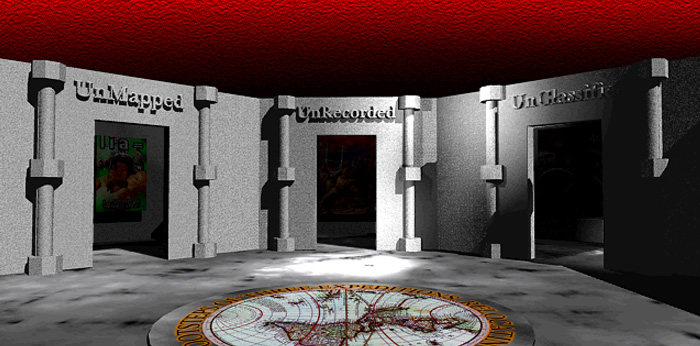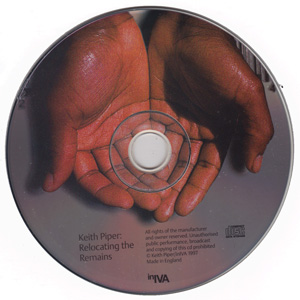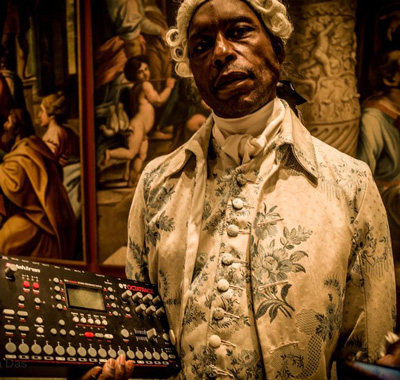The ‘Relocating the Remains’ interactive CD-Rom was completed in 1997 as a component of a larger project of the same name. This project was composed of a touring exhibition, an artist monograph, the CD-Rom, a website and a live ‘VJ’ event called ‘Club Mix’.
Commissioned by InIVA (The Institute of International Visual Art) initially as a ‘mid-career retrospective’, my response was to explore uses of emerging ‘interactive technologies’ to ‘revisit’ work from the 1980s and 90s in the form of digital facsimiles that could be explored through user browsable devices.
For the central gallery-based exhibition, this involved developing a series of installations exploring thematic elements of my practice using various screen and video projection-based strategies in combination with physical installation, mixed media and light boxes. This exhibition will be explored in depth elsewhere.
The interactive CD-Rom element of the project explored this ambition through the use of virtual, digital media and interactive authoring tools found on the Apple Macintosh computer during the mid 1990s. Principally using MacroMedia (now Adobe) Director, a user ‘interactive’ project was assembled initially on and for the Apple Macintosh, with a ‘dual platform’ version of the work developed the following year that was also playable on ‘Windows’ based computers.
The work was organised around the metaphor of a multi-roomed physical gallery space that a user could explore, encountering different works through a series of visual interfaces arranged in virtual ‘rooms’. These ‘rooms’ were ‘curated’ thematically, clustering bodies of work from the 1980s onwards into three broad categories accessible through three ‘doorways’. Unmapped (the unmapped body) Unrecorded (unrecorded histories) and Unclassified (themes of surveillance and classification).

The aesthetics of these virtual ‘facsimiles’ of galleries and other objects were deliberately ‘retro’ in appearance, evoking timber crates and columned stone walled exhibition spaces. This was an attempt to use the ‘modernist’ device of the computer to sample and quote visual strategies from ‘pre-modern’ and ‘analogue’ settings. This use of artifice and quotation locates the work solidly within a ‘postmodern’ distancing from the purist and rational strictures of ‘modernism’. It does this whilst simultaneously exploring the strategic possibilities of ‘cutting-edge’ contemporary technology as a means of accessing and exploring historic and archival material.
This futuristic optimism in technologies ability to offer alternative means for audiences to engage with cultural artefacts, archives and information was a point of discussion amongst digital practitioners of the era. It was certainly a factor propelling my interest in this project, and an engagement shared with InIVA’s then digital manager and technical collaborator for the project, artist Gary Stewart.
More than two decades on, this futuristic ambition to see digital and virtual space deployed for the accessing of information, cultural and media artefacts, archival records and an almost infinite range of other possibilities, has I would argue, been richly realised by the ubiquitous and global spread of the internet as a space for viewing, interacting with and depositing information in a diversity of digital formats.
However, on route to this ultra-portable, ‘platform agnostic’ ‘rich media’ feast of the contemporary internet, there have been multiple ‘Darwinian culls’ and ‘extinction level events’ for many of the computer platforms, software systems, tool sets and media packages that landmark our progression towards the present (or in some cases, that signal evolutionary ‘dead-ends’).
We are often left with the need for acts of ‘digital archaeology’. A painstaking excavation of defunct, decaying media storage systems and long extinct hardware and software platforms in an attempt to re-engage with cultural and creative material left stranded by the rapid churn of evolving digital technologies. A celebrated example of this was the excavation in 2014 of Andy Warhol’s experimental artwork using the long defunct Amiga Computer for its launch event in 1995.
I discuss this, alongside my own early use of the Amiga in my blog essays ‘a Glitched Practice (Pt-1) & 'a Glitched Practice (Pt-2).
The CD-Rom component of Relocating the Remains experienced this ‘techo-evolutionary’ act of ‘stranding’ with its informational, visual and sonic content becoming progressively less accessible as the hardware and software carriers for which it was originally encoded become increasingly archaic.
The project was originally delivered on a CD-Rom, neatly packaged on the inside back cover of the exhibition Monograph. A format widely used in the 1990s, the CD-Rom was superseded by the higher capacity DVD disk until the exponential development of online resources rendered the ‘optical disk’ as a carrier of content itself archaic.
The project was authored using the software package ‘MacroMedia Director’ using its internal interactive programming language, ‘Lingo’. The significance of Director and Lingo to the development of my practice is explored within the in-progress video essay ‘Code: Software, Signifyin & CyberEbonics’ and will be further explored elsewhere.
However, the ‘flavour’ of Lingo used in the early work was itself to become ‘archaic’ within progressive versions of Director, and the software application was finally discontinued in by Adobe in 2017. As with many works of this era, the ‘Relocating the Remains CD-Rom’ is currently undergoing a process of excavation to be potentially engaged with, in close to its original ‘interactive’ form in a proposed collaboration with DACS and iDAT (University of Pymouth).

